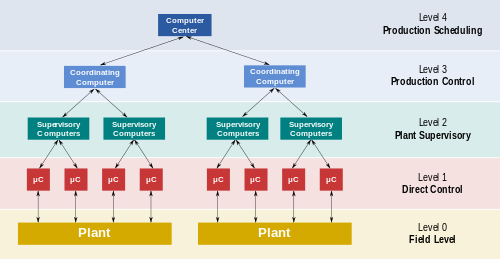监督控制
监督控制(Supervisory control)是指控制许多个别控制器或是控制回路的控制,例如在分散控制系统中的控制。监督控制是指在较高的层次监控所有的过程控制器,不一定要针对每一个控制器的运作,不过要提供操作者整体流程的情形,而且可以整合各控制器之间的运作。
数据采集与监控系统(SCADA)就是监督控制的例子,数据采集与监控系统是特别用在过程控制中的系统,设备一般不大,可以进行像管输工艺、供水或是废水系统的远端操控。
形式[编辑]

监督控制有二种不同的型式。一种是让受控的机器或是程序持续运作,也可能会有操作人员随时监控,在必要时调整控制算法。另一种系统中的程序会接受指令,自动执行,回复结果,然后等待新的命令。需要人工控制时,操作者可以用开关、按钮、阀门或是控制杆来控制制动器。在早期的机器中就有这类的概念,目的是希望可以扩展人可以处理的事物量。若监督控制是自动控制,机器会适应变化的环境,并且为了一特定目的而下一些决策,例如为了维持室内温度在一定范围内,因此开启或关闭室内的暖气系统。Sheridan [1]对监督控制的定义如下:“严格来说,监督控制是指一个或多个人间断性的编写程式,持续性的从电脑获取资讯,而电脑本身透过控制程序或是任务环境形成一个自动执行的控制回路。”
其他特点[编辑]
机器人应用以往只针对自动化控制的领域。自动化控制需要可以侦测环境所有条件的组合,并且加以处理,可以而这些条件可能代表了有惊人复杂度的问题。监督控制可以让系统自行处理越来越多的问题,只将无法自行处理的问题留给人工来判断。
相较于控制回路,监督控制中的通讯延迟影响不会那么严重。所有紧急的回授及处理都是在设备上进行,相对于监督控制,设备本身延迟是可忽略。因此不会有因为修改回授环而造成的不稳定。监督控制中的通讯延迟会降低操作员指定工作给设备的速度,也会让操作员花较多时间才能确认各工作的处理情形。
相关条目[编辑]
- 人因可靠度及人因工程学
- Thomas B. Sheridan:麻省理工学院研究监督控制的研究者
- 监督控制理论
参考资料:人工监督控制[编辑]
- Amalberti, R. and Deblon, F (1992). Cognitive Modelling of Fighter Aircraft Process Control: A Step Towards an Intelligent On-Board Assistance System. International Journal of Man-Machine Studies, 36, 639-671.
- Hollnagel, E., Mancini, G. and Woods, D. (Eds.) (1986). Intelligent decision support in process environments. New York: Academic Press.
- Jones, P. M. and Jasek, C. A. (1997). Intelligent support for activity management (ISAM): An architecture to support distributed supervisory control. IEEE Transactions on Systems, Man, and Cybernetics, Special issue on Human Interaction in Complex Systems, Vol. 27, No. 3, May 1997, 274-288.
- Jones, P. M. and Mitchell, C. M. (1995). Human-computer cooperative problem solving: Theory, design, and evaluation of an intelligent associate system for supervisory control. IEEE Transactions on Systems, Man, and Cybernetics, 25, 7, July 1995, 1039-1053.
- Mailin, J. T., Schreckenghost, D. L., Woods, D. D., Potter, S. S., Johannsen, L., Holloway, M. and Forbus, K. D. (1991). Making intelligent systems team players: Case studies and design issues. Volume 1: Human-computer interaction design. NASA Technical Memorandum 104738, NASA Johnson Space Center.
- Mitchell, C. M. (1999). Model-based design of human interaction with complex systems. In A. P. Sage and W. B. Rouse (Eds.), Handbook of systems engineering and management (pp. 745 – 810). Wiley.
- Rasmussen, J., Pejtersen, A. and Goodstein, L. (1994). Cognitive systems engineering. New York: Wiley.
- Sarter, N. and Amalberti, R. (Eds.) (2000). Cognitive engineering in the aviation domain. Lawrence Erlbaum Associates.
- Sheridan, T. B. (1992). Telerobotics, automation, and human supervisory control. MIT Press.
- Sheridan, T. B. (2002). Humans and automation: System design and research issues. Wiley.
- Sheridan, T. B. (Ed.) (1976). Monitoring behavior and supervisory control. Springer.
- Woods, D. D. and Roth, E. M. (1988). Cognitive engineering: Human problem solving with tools. Human Factors, 30, 4, 415-430.
参考资料[编辑]
- ^ Sheridan, Thomas B. Telerobotics, Automation, and Human Supervisory Control. MIT Press, Cambridge. 1992: 1 [2018-10-01]. ISBN 978-0-262-19316-0. (原始内容存档于2012-11-11).
